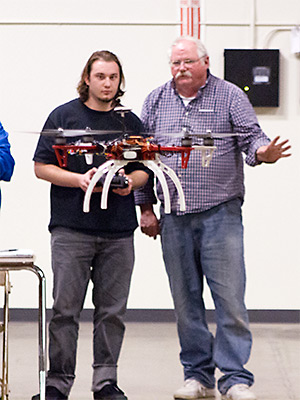
Students enrolled in an Unmanned Aerial Systems course take turns flying drones.
The first-ever flight of 300 Unmanned Aerial Vehicles (UAV) at the 2017 Super Bowl points to how these aircraft are increasingly being used in different industries and for unique purposes—highlighting what may be a definite growth in careers involving Unmanned Aerial Systems (UAS).
Choreographed and glittering UAV, or drones, were featured over Lady Gaga’s head during her halftime performance on Sunday, Feb. 4 in Houston, TX. After first appearing as white stars in the sky, they glided into positions forming a red and blue representation of the U.S. flag.
The flight marks the first time drones have been used at the Super Bowl, according to CNN. Also, hundreds of lightweight foam and plastic drones flew in formation for “Starbright Holidays—An Intel Collaboration” show, through an entertainment partnership by Disney and Intel Corporation.
“Now that entertainment drones have officially performed without a hitch on the biggest stage ever, expect to see a lot more flying robots incorporated into major performances,” wrote Adario Strange on Mashable.com.
Mark Sharp, UAV Instructor at Truckee Meadows Community College, said that the uses for drone technology are rapidly growing and expanding, leading to even more job opportunities for those who can fly and repair UAS.
February is National Career and Technical Education (CTE) Month
TMCC has announced a Late Start class in UAS during Spring Semester that still has open seats. The class is an introduction to UAS technology, held at the William N. Pennington Applied Technology Center:
- AV 101: Introduction to UAV, section 8002: Mar. 28–May 11 from 2–5:30 p.m. on Tuesdays and Thursdays
TMCC offers a Certificate of Achievement: Unmanned Aerial Systems Technician. The program prepares students in the safety, operation and maintenance of this leading-edge technology.
“UAV are capable of a multitude of tasks, efficient, inexpensive to build, and can carry out some of the tasks much more safely than manned aircraft,” Sharp said.
The drones flying at the Super Bowl were automated—each one was equipped with a Global Positioning System (GPS) accurate to one-and-a-half meters, so they could fly up to about 4-and-a-half feet apart, he added.
“That makes it possible to fly hundreds in synchronization,” he said. “Also, it means that a person has to build the aircraft, determine the design of the choreography, figure out how to carry out the design and then adjust the programming for hundreds of drones.”
Opportunities in UAV Include Much More than Entertainment
Employing drones for entertainment is only one of the careers available in UAS. Unmanned Aerial Systems are being used in a wide array of occupational areas in private business and public agencies including, but not limited, to the following:
- Agriculture
- Commercial delivery
- Firefighting and suppression
- Law enforcement
- Mapping
- Mining
- National Defense
- Power and gas utilities
- Public transportation
- Real estate
- Research projects
- Search and Rescue
- Watershed analysis
Drones can collect a vast amount of data very quickly, and many new products will be built with the data in fields such as mapping, exploration, rescue, and inspection.
“You need to know UAS fundamentals, how the control station talks to the drone and what frequencies might conflict with each other,” Sharp said. “Another part is safety. You need to know safe landing procedures, such as when the battery is low. We teach the fundamentals well here at TMCC.”
For more information about studying UAS technology at TMCC, contact Barbara Evans in the Technical Sciences Division at 775-856-5302, or Mark Sharp at 775-856-5325.






